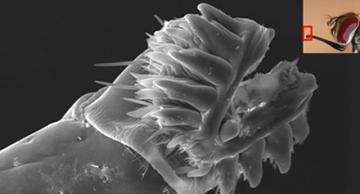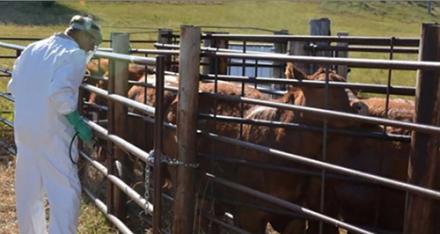ARS Scientists Team Up to Fight Flies
Researchers Join Forces, Use Coconut to Create Longest-Lasting Natural Insect Repellent

A stable fly mouth part viewed through scanning electron microscope. (Photo courtesy of Steven Cermak)
Every year, stable flies and other blood-feeding pests take a $2.2 billion bite out of agriculture. Recently, three scientists from the Agricultural Research Service (ARS) decided to combine forces to combat the irritating insects. In a collaborative effort, they used their specialties in entomology, organic chemistry, and processing technology to turn the humble coconut into the longest-lasting natural repellent product studied to date.
Steven Cermak, research leader at the ARS National Center for Agricultural Utilization Research (NCAUR) in Peoria, IL; James Kenar, chemist at NCAUR; and Jerry Zhu, lead entomologist and chemical ecologist at the ARS Agroecosystem Management Research Unit in Lincoln, NE, discovered that coconut fatty acids had exceptionally strong repellent qualities against various blood-sucking pests.
Their findings are significant, because stable flies produce painful bites that cause stress to cattle that in turn leads to economic losses to all sectors of the U.S. cattle industry. Besides direct physical injury, stable flies can transmit viruses, bacteria, and parasites to the cattle.
“Animal stress and disease affect milk production in dairy cows,” Cermak said. “In the leather industry, bite marks damage hides and influence leather quality. Finally, costs associated with animal welfare – to treat disease, and deal with animal loss – can be enormous. So, it is important to keep the animals free of these types of pests.”
Certain fatty acids, referred to as medium chain fatty acids, are known to have strong repellency and long-lasting effectiveness against multiple insects, such as mosquitoes, ticks, biting flies, and bed bugs that can transmit diseases to both humans and animals, Cermak explained. Although some other plant oils also possess the compounds, nearly two-thirds of coconut oil is made up of the desired medium chain fatty acids.
“These fatty acids repelled biting flies and bed bugs for two weeks after application, and ticks for one week,” Zhu said. “Our initial testing of an aqueous starch-coconut fatty acid formulation protected pastured cattle from biting flies up to 96 hours in the hot summer. To our knowledge, this is the longest protection provided by a natural repellent product studied to date.”
As important as repellency is, it won’t do any good if it cannot be applied in a safe manner for the animals and the environment. In this case, the team used a starch and water mix to carry the coconut fatty acids.

A University of Nebraska student applies coconut fatty acid insect repellent to livestock during field trials. (Photo courtesy of Steven Cermak)
“The materials had to be applied easily as a lotion or spray, be cost effective, and be able to be prepared easily and scaled to accommodate potential market size and demand,” Cermak said. “But, because coconut fatty acids are not water soluble, delivering them in a water-based system was challenging.”
Fortunately, the scientists turned to a technology previously developed at NCAUR. The process incorporated jet cookers to disperse starch and the coconut fatty acids into water. The slightly viscous mixture allows for dispersal of coconut fatty acids in small droplets that do not rapidly stick together.
“There are still tweaks and improvements we can make, but, based on previous research and experience, we expect the material can be dried to a powder so it can be shipped without the added water weight, stored, and then rehydrated as needed for use,” Kenar said.
Coconut oil and its derivatives are renewable resources and because both coconut fatty acids and starch are used in food products, they are recognized as safe.
“Although the majority of our research using coconut fatty acids has been focused on livestock applications, we also see potential commercial applications that include skin lotions, textiles, and agricultural applications for crop protection, and even for garden snails in our backyards,” Zhu said.
“Finding more effective natural insect repellents presents challenges and opportunities,” he said. “We are always on the lookout for alternative repellents and have several ideas we are pursuing, and early results are promising.” – By Scott Elliott, ARS Office of Communications.
You May Also Like

